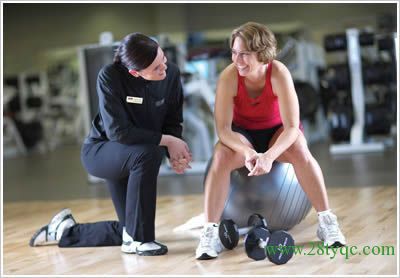New Year for you to develop an exclusive fitness program
In 2012, new beginnings always promise new aspirations, and having health is our common wish. A harvest will have a harvest, health is also the case. May wish to set a fitness plan and promise yourself a healthy future. Comprehensive assessment preparation According to the International Association for the Prevention of Aging, before starting a fitness program, it is best to prepare for the following assessments: • Do a physical examination. Ask your doctor if you can start a fitness program and adjust it for your own situation. • Identify your favorite sport so that you can adhere to it. • Examine facilities and personnel. For example, is the atmosphere of a fitness facility friendly? Is the facility easy to use? • Determine how to participate. Choose a way that suits you best – on a collective class or on a separate exercise? Exercise in the morning or exercise in the evening? • Find a friend. Find a partner who can exercise together and inspire you. Formulate detailed short-term and long-term goals, arrange good workouts and give full attention to them. • Create a list. The pursuit of "controllable" practical benefits, such as reducing stress, relaxing emotions, sleeping better, etc., rather than just achieving a certain result, such as weight loss. Fitness process calendar card Circle important dates on the calendar and note down memos. The calendar also helps us to plan more. The United States has a best-selling book on fitness, specifically designed for those who are willing to have no time, no time and perseverance, "lazy people" designed a training program, clever use of "time and place", so that a full year of exercise is full of fun. January: Make a good foundation Don't hurry to make a success. Gradually adapt your body to the rhythm of the movement. You can incorporate daily basic sports into your everyday life. Exercise requirements: 4 times a week physical flexibility, balance exercise; 3 times at least 15 minutes of aerobic exercise; walk at least 4000 steps a day. February: Increased muscle training can speed up your metabolism, which will help you shape your body shape. Exercise requirements: Start resistance exercise. Perform this exercise against a box or wall at least twice a week. Together with abdominal muscle exercises to enhance the body's strength and balance. March: After a few weeks of resistance to tiredness, your motivation and enthusiasm may fade. List all the reasons you want to improve your health and regain your passion for sports. Exercise requirements: Introduce recreational sports (such as boating, outings, etc.) in your daily sports and enjoy sports with your friends. April: Walk 7,000 steps a day Now that you have laid a solid foundation, with standard posture and basic adaptability, you should go further. Exercise requirements: Increased to 7000 steps per day and started outdoor aerobic exercise. If you've been jogging, increase your pace and increase your exercise intensity. Exercise yoga after aerobic exercise to help relax muscles. May: Strengthen the summer of aerobic exercise. You should increase the intensity of aerobic exercise to shape your body while maintaining healthy fat levels. Exercise requirements: The number of walks per day increases to 7000 to 10,000. Add interval strength training to the aerobic exercise program. June: Abdominal exercises shape body shape to create a good body shape and build confidence in the body. Exercise requirements: Abdominal training should be performed at least 4 times a week. This is the place where fat is most likely to accumulate. It is absolutely necessary to fight for "defense." July: When people who exercise better in the water and have perseverance also get bored, give yourself a rest time. You can spend less time doing programmed exercises in the gym and do more fun outdoor sports. Exercise requirements: Walk at least 10,000 steps a day and start exercising in the water. Plan more outdoor activities - such as a picnic outing. August: Try extreme sports out of the regular exercise circle and have different feelings at different locations. Exercise requirements: If you mainly use running, then try to run in the water this month; if you used to exercise outdoors, try indoor exercise; you can also try some challenging projects such as rock climbing. September: Consolidate fitness results The focus of this month is to increase daily exercise and consolidate the fitness effects of the previous period. Exercise requirements: record your daily exercise volume on a daily basis. In the fall, you may stay indoors longer. Therefore, arrange outdoor sports every day. October: Checking Out the Effect You can schedule a race at the end of this month to test your workout. Exercise requirements: Add yoga exercises to the original exercise plan at least 3 times a week. Perform a stable workout to ensure muscle balance. November: "Self-cultivation", relaxing the body This month's task is to relax yourself. You have achieved the exercise effect and your body has to rest for a while. Pay attention to the recovery of both body and mind, and at the same time do some basic training in balance. Exercise requirements: To participate in some "self-cultivation" activities, such as Tai Chi or yoga, to fully relax the body. Don't overlook the daily minimum required walking requirement. December: A reasonable arrangement of exercise time to the end of the year, which will be a busy month, you need to ensure that there is time for physical exercise on the calendar. Exercise requirements: Try to "close your eyes and mind" exercises and meditation, relaxation to obtain high quality sleep. You can walk out of the house on weekends and choose to spend the winter outdoors with your family. According to age adjustment exercise strategy In the new year, everyone is one year older. Some will enter adults and some will enter middle age. As we age, the focus of our sports needs to change accordingly. More than 20 years old can choose high impact aerobic exercise, running or boxing and other sports. The good thing for your body is that it burns a lot of calories, strengthens your body muscles, increases energy, endurance, and hand-eye coordination. In the thirties, rock climbing, skating or martial arts are recommended for fitness. In addition to weight loss, these exercises can strengthen muscle elasticity, especially the buttocks and legs; it also helps to increase endurance and improve your sense of balance, coordination and sensitivity. Psychologically, rock climbing can cultivate meditation-like concentration and help you build self-confidence and thinking power. Martial arts can help you stay calm, self-motivated, and alert in conflict. Forty-year-old chose low-impact aerobic exercise, travel, stairs, tennis and other sports. The benefit to the body is to increase physical strength and strengthen the lower body muscles, especially the legs. Tennis is a very suitable full-body exercise, which can increase the sensitivity and coordination of various parts of the body, allowing people to maintain vitality. At the same time, the pressure on the joints is less than that of running and high-impact aerobic exercise. Suitable sports for the fifties include swimming, weight training, and boating. Swimming can effectively strengthen the muscles and elasticity of various parts of the body, and because of the buoyancy support of water, it is not as good as sports on land. It is particularly suitable for convalescents, rheumatism patients and older people. Weight training strengthens muscles, strengthens bone density, and increases other exercise capabilities. More than 60 years old suggest that you do more walking, ballroom dancing, yoga or water aerobics. Walking strengthens the legs and helps prevent osteoporosis and joint tension. Ballroom dancing enhances the rhythm, coordination, and grace of the whole body, making it ideal for those who do not exercise regularly. Yoga enhances flexibility and balance, preventing body injuries. Water aerobic exercise can mainly increase muscle strength and body elasticity, and it is suitable for fitness for obese or old and weak people.
Gravure The finished product in this way is usually called a non-woven fabric bag. This process is divided into two steps, that is, the traditional gravure printing process is used to print the text onto the film, and then laminating the patterned film on the non-woven fabric by laminating process. A large area of color pattern printed non-woven bags are used in this process. It is characterized by exquisite printing, full use of machine production, short production cycle. In addition, the product has excellent waterproof performance, and the durability of the finished product is better than that of Non-woven Bag produced by other processes. The film has two options: bright and Matt. Matte has a matte finish
Laminated Nonwoven Bag,Laminated Non Woven Carry Bags,Laminated Non Woven Bags,Laminated Non Woven Tote Bags Baoding Sympathy Bags Manufacturing Co., Ltd. , https://www.sympathybag.com

